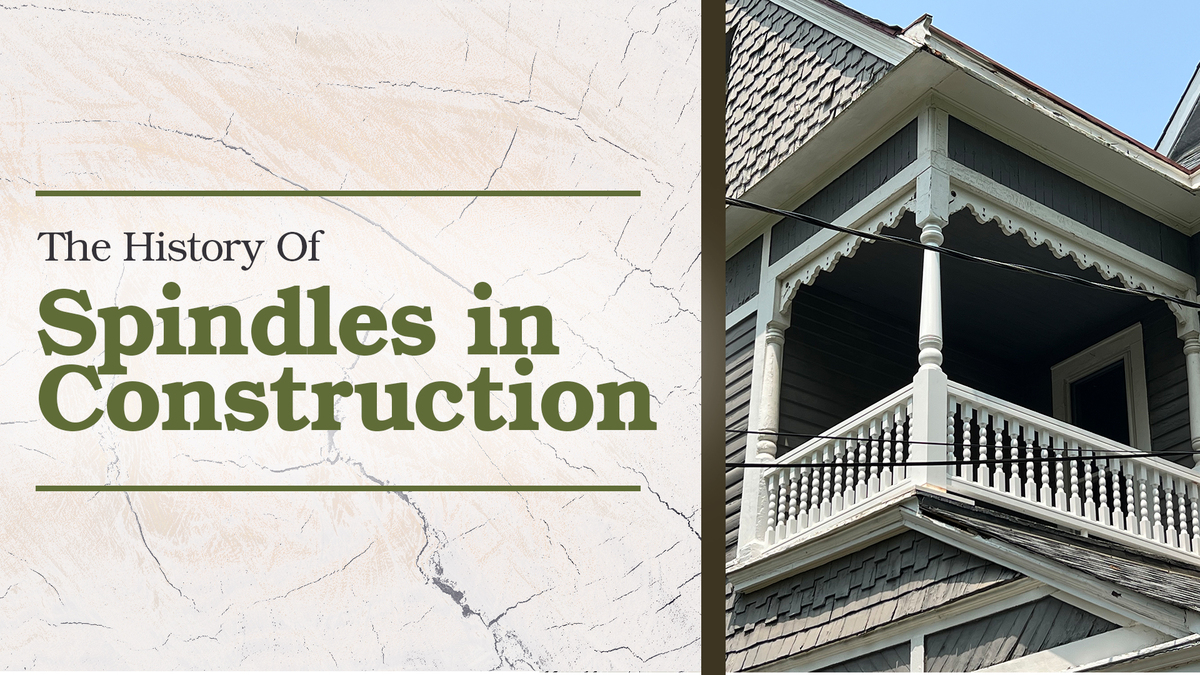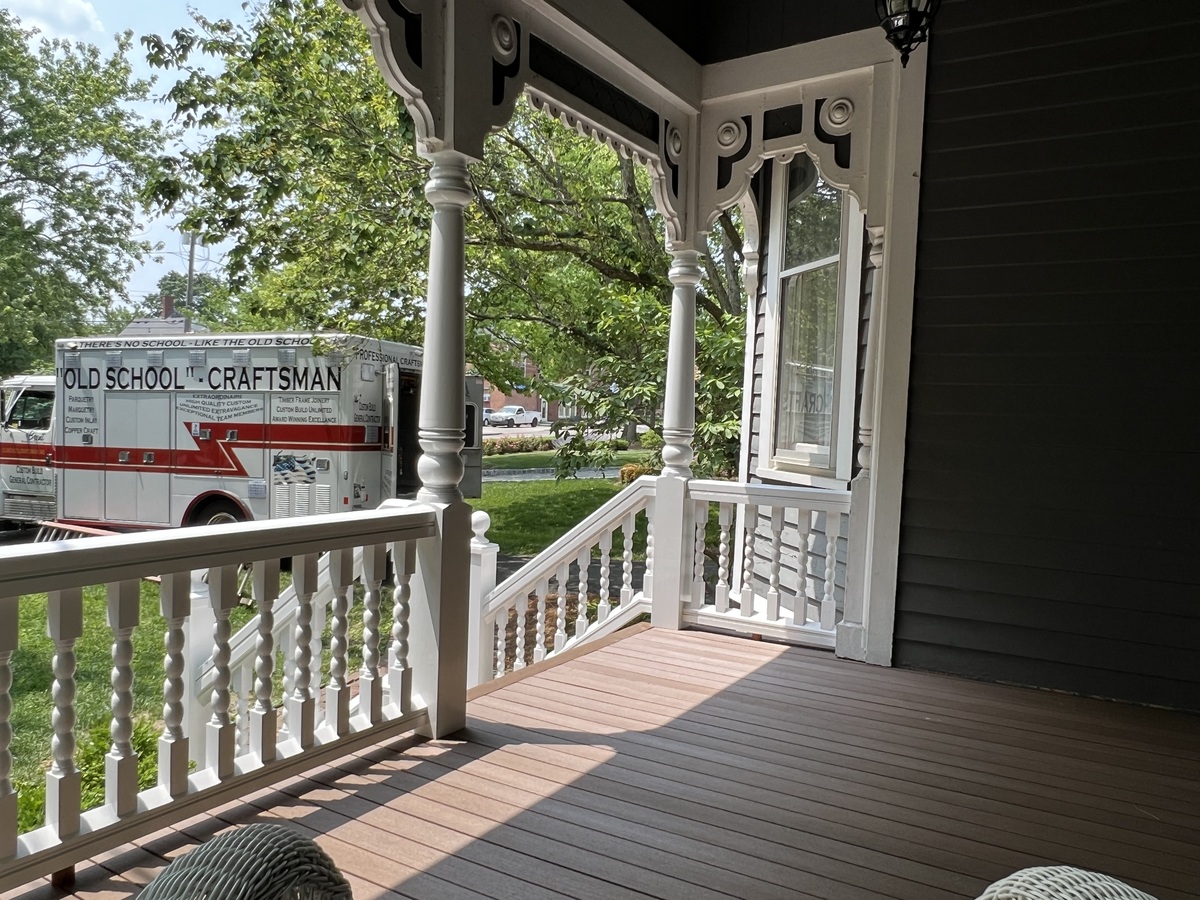The History of Spindles in Construction

At Old School Craftsman, we have been making a lot of spindles as of late. One reason for this is that Brendon and I have recently invested in a trio of CNC robots. But another reason is the rise of historical restorations, like the Victorian Porch Project, which often relies on spindles to establish a stylistic period.
In researching spindles and different details, I began to learn a lot about them and their history. I already knew a good deal, but I was surprised by just how rich their history was.
In this post, I will give you a brief history less on the spindle. I will tell you about what spindles are, why we use them, their origins, and why they are so important for many historical restorations. Get thinking about how spindles can be used in your next project as you learn more about how this beloved home feature got its start.

What are Spindles and Why Do We Use Them?
Spindles are thin, upright components that are commonly used in architecture and construction, particularly in balustrades or staircases. These spindles play a crucial role in providing support, safety, and aesthetic appeal to various structures.
In balustrades and railings, spindles are positioned vertically to form a protective barrier or enclosure along staircases, balconies, decks, and other elevated areas. By acting as vertical components between the handrail and the bottom rail or floor, they contribute to the overall stability and safety of these structures.
Beyond their functional importance, spindles also add aesthetic value to architectural designs. They come in various materials, such as wood, metal, or glass, and can be designed in different styles and shapes. This allows them to enhance the visual appeal of the spaces they are used in, whether it be a modern, sleek staircase, or a classic, ornate balcony.
Spindles are essential elements in architecture and construction due to their ability to provide support, safety, and aesthetic qualities. They play a dual role in protecting individuals from falling off elevated areas while also adding beauty and elegance to the overall design of the structure.
Little details like spindles matter a whole lot when it comes to evoking a certain period. Learn more about some other finishing touches here!
The Origin of Spindles
Spindles, some people call them balusters, have a rich history. Their origins date back to the Assyrian Palaces of ancient Mesopotamia where they were used for ornamental purposes - to convey power while they supported the weight of light structures.
During the Renaissance period in Italy, spindles gained widespread recognition and popularity, thanks in part to the renowned architect Giuliano da Sangallo. His work on Tuscany's Medici Villa showcased the beauty and elegance of spindles, earning him the limelight in architectural circles.
However, spindles did not fade into obscurity after the Renaissance. They were used in architecture throughout the 20th century and even during the Victorian era. These intricate and ornamental elements added a touch of sophistication to buildings, both old and new.
Today, spindles can still be found in various architectural styles, from classical to contemporary. Their timeless appeal and historical significance make them a cherished feature in many structures around the world.
The Importance of Spindles in Historical Restoration
When it comes to historical restoration, attention to detail is paramount. From architecture to interior design, every element must be carefully considered to ensure accuracy and authenticity. One often overlooked yet crucial aspect is the use of spindles.
Spindles, those small decorative elements often found in staircases, furniture, and other wooden pieces, may seem insignificant at first glance. However, they play a significant role in contributing to the realism of a particular period. They provide subtle cues and intricate details that transport the observer back in time. Whether it's the delicate curves of the Victorian era or the clean lines of mid-century modern design, the use of spindles can greatly enhance the overall appeal and accuracy of a historical restoration project.
Not only do spindles contribute to realism, but they also possess subtle complexities that greatly alter the style and function of a space. For example, the spacing, shape, and design of spindles can influence the visual aesthetic and flow of a staircase. Choosing the right one can transform a plain staircase into a stunning architectural feature that captures the essence of the chosen period.
Another aspect to consider is the evolution of spindles throughout the 20th century. By studying the differences in design and style, historians and restoration experts can accurately recreate a specific period. Spindles from the early 1900s may differ significantly from those of the 1950s, for instance. Understanding these discrepancies is vital for maintaining accuracy and historical integrity in restoration projects. That means if I want to restore a building constructed in 1910, the spindles may be drastically different than those made in 1930. This is where the CNC robots help a great deal!
These seemingly minor details add a level of realism and authenticity that transport observers back in time. By carefully selecting and replicating spindles, restoration professionals can breathe life into historical spaces and accurately capture the style and function of a bygone era.
Your Next Project with Old School Craftsman
Summer is the time of custom home rebuilds and historical restorations. With the new shop built, the Old School Craftsman team is now specializing in the smaller details of restorations. Things like spindles and custom details can all be produced in our shop and then shipped to you. This means you will spend more time enjoying the dazzling home upgrades courtesy of our team.
I want to hear your ideas for home upgrades. Brendon and I are here to make them come to life!
Let's get started! Click here to reach out to Old School Craftsman today!
Follow us on Facebook, Instagram, and Pinterest for more discussion on historical homes and updates from our most recent projects.
Happy with the difference Old School Craftsman made on your home refurbishment? Leave us a five-star review here!
